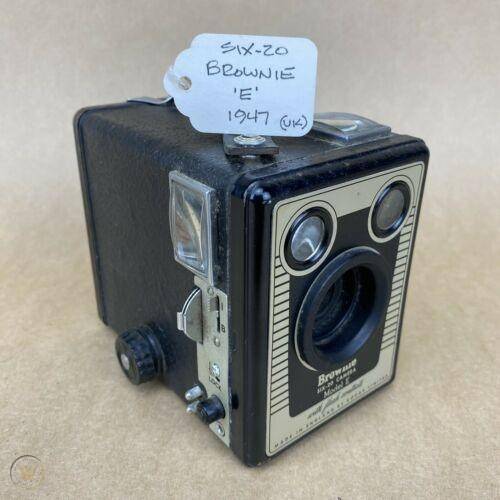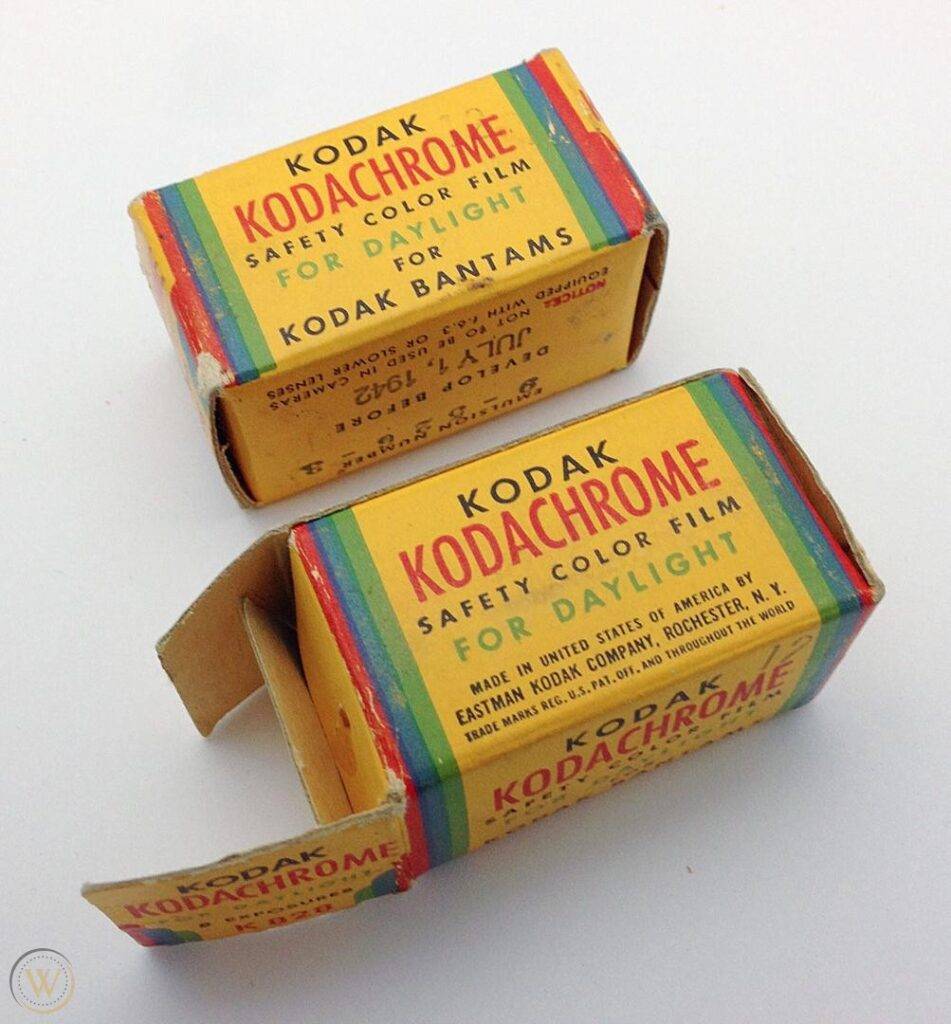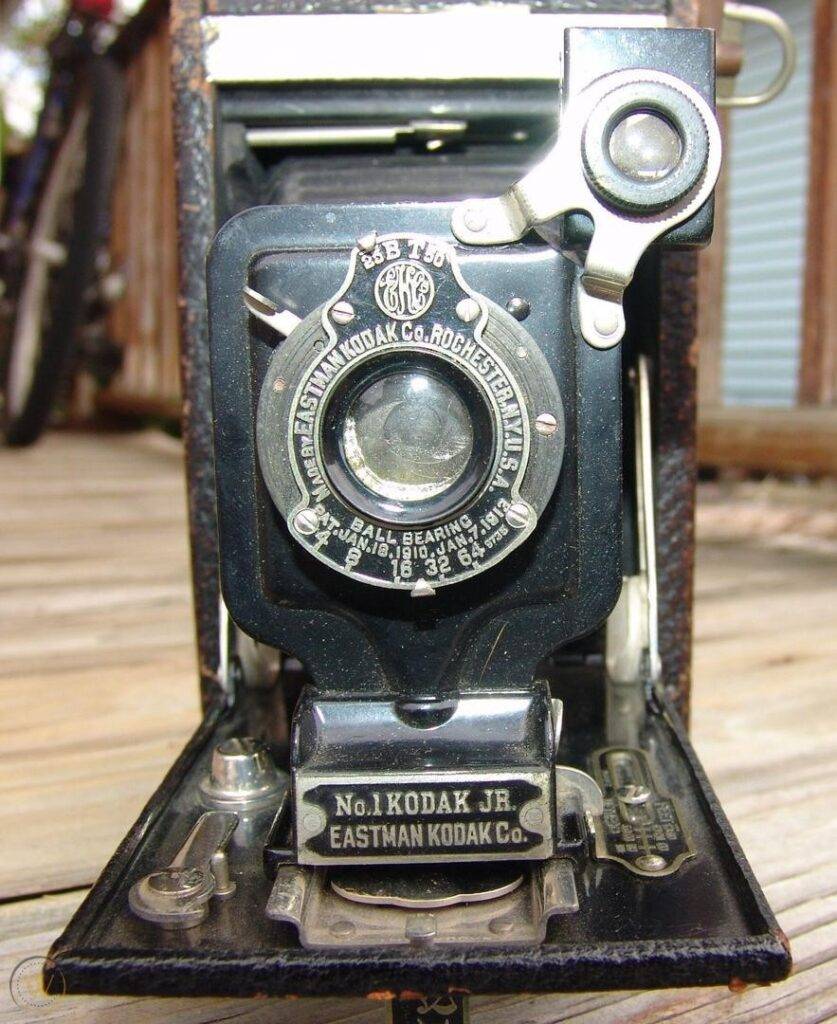The Eastman Kodak Company
In the 1880s, George Eastman was developing a commercially viable portable camera that used flexible film instead of large glass plates to produce still photographs. Introduced in 1888, the “Kodak Camera” was one of the first mass-produced film cameras on the market. Retailing for $25 (about $692 today), it came preloaded with a 100-exposure roll of film and produced circular images roughly 2 ⅝” in diameter. This distinctive image shape makes it easy to identify images that were created with this Original Kodak, also known as the Kodak 540. Since film development had yet to become widespread, photographers had to mail the entire device back to Kodak to have the film developed and the enlargements (or prints) made. Its successor, the Kodak No. 1, was very similar but had a different shutter mechanism. Both were fixed aperture and somewhat unreliable but remained available until 1895 when production shifted to developing and manufacturing a new model – the Kodak Brownie.

The Kodak Brownie made photography accessible for a much wider audience than ever before. Sold for $1 (about $31 today), the Brownie was the first camera to be mass-produced and marketed to the middle class. It was an instant hit. Thousands of cameras were sold, which put the power of photography into the hands of amateurs and artists alike. The Brownie used a different shutter mechanism than its predecessors and did not require that Kodak handle all aspects of development and printing. It was the most straight-forward, consumer-friendly camera yet, so much so that it inspired a new slogan: “You press the button, we do the rest.”
This ease of use translated into widespread popularity for the Brownie. In the 1890s and into the early years of the 20th century, photography became a national craze for Americans. “Kodak” entered the public lexicon and was used in many different forms. For instance, the term “Kodaking” became another word for “photographing,” and photo enthusiasts wielding a Kodak camera were often dubbed “Kodakers.” Amateurs took to the medium like wildfire, quickly forming photography clubs and associated magazines. No longer bound to only commemorating life’s biggest moments at great cost, amateurs led photography into the cultural vernacular by taking photos of everyday life and giving us glimpses into what was valued and important to people of the past.
In these early days of amateur photography, photographers were drawn to many of the subjects still enjoyed by today’s artists and amateurs. Important life events like weddings, annual parades, and parties were common subjects. People who could afford to travel often documented their adventures. Those less affluent often took photographs of their towns and nearby areas, capturing parts of life that hereto may have been overlooked within the medium. As the leisure class continued to expand, they snapped photos of the seaside and picnics, gatherings, and holidays. During this time, we also see photographs of babies and children, homes, and their interiors. Yes, people even took pet pics back then.
This era also saw a rise in more artfully posed portraits. In the 1890s and early 1900s, one particularly widespread trend was photographing subjects from behind. Typically shot in a reverse of ¾ profile, we often see women photographed with their back to the camera, their head turned over their shoulder with their face somewhat visible. In a similar vein, we see many images of individuals and couples shot from behind within a landscape, their bodies turned completely away from the camera, much like images we often see today of people visiting National Parks or taking in sweeping vistas abroad.
As photography became increasingly widespread, practitioners and critics alike began to debate the status of photography as an artistic medium. Differentiated from other arts by their unique equipment and materials, professional photographers of this era argued that photography was still an artistic medium in spite of their mechanical processes. A few decades later, in the 1920s and 30s, many documentary photographers like Ansel Adams, Walker Evans, and Dorothea Lange, proved that the medium’s documentary capabilities were by no means a barrier to its equally breathtaking artistry. As the medium continued to evolve in its technological sophistication and creative prowess, photography gradually secured its place in the art world.
Color Photography, 35mm Film & Beyond
Inspired by the popularity of the Brownie, other individuals and companies started to develop new photographic technologies. In 1912, Rudolf Fischer and Hans Siegrist developed a color film process that ultimately paved the way for the advent of Kodachrome, which was the first iteration of color film. In 1913, 35mm film was introduced and quickly became an industry standard after Leica introduced their first cameras. 35mm went on to become the most popular means of shooting film photography for roughly 60 years, only winding down (pun intended) with the introduction of commercial digital photography. Kodak would go on to continue introducing new technologies, like new generations of film, Super Glue, and the first digital camera.

Since 1880, photography itself has become part of the fabric of everyday life, no longer bound to film, and accessible to nearly everyone today thanks to the rise of smartphones. So snap another photo of your dog and share it with everyone you know. It’s what your artistic forefathers would have wanted.
Megan Shepherd is a curator, fine art appraiser, freelance writer, and artist. She has worked in fine art museums for a decade and holds two master’s degrees in the field. When taking a break from art she enjoys science-fiction novels, trail running and quilting.
This article was originally published by WorthPoint on WorthPoint.com


